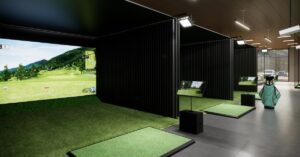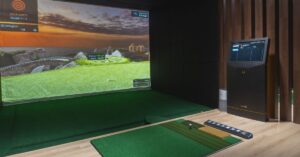One of the most common questions golfers ask when they step into a simulator bay is, “How does this thing actually work?”
It’s understandable. You take a swing, the ball travels a few feet, and suddenly a lifelike drive appears on screen, complete with spin, trajectory, and carry distance. It feels like magic. But the truth is, that seamless experience is built on an impressive combination of physics, precision cameras, and advanced software.
The Core of It All: Data and Design
At their foundation, golf simulators rely on high-speed tracking systems, specialized sensors, and sophisticated analytics to measure every aspect of a golf shot from launch to landing.
There are several main types of tracking technologies used in the industry:
- Radar simulators (like TrackMan) measure the ball’s full flight using Doppler radar, the same technology used in weather forecasting.
- Photometric simulators (like Golf VX and Foresight) rely on ultra-high-speed cameras that record the moment of impact in detail, capturing ball and club data instantly.
- Infrared simulators use beams of invisible light to capture club movement, face angle, and impact dynamics.
At Golf VX, we use photometric technology because it delivers the highest accuracy in controlled simulator environments. High-speed cameras capture precise data at the point of impact, making it ideal not only for full swings but also for short game tracking, where accuracy and consistency are critical. By measuring every small detail, our system provides the truest representation of real-world performance indoors.
So, How Does a Golf Simulator Work?
In simple terms, the simulator measures your swing, processes the data, and translates it into a digital shot.
Each swing generates hundreds of data points, including ball speed, launch angle, spin rate, club path, and face angle. This information is processed by advanced physics software that calculates how the ball would travel in real-world conditions.
Within seconds, you see your shot projected in full, complete with trajectory, carry distance, and roll-out. If you’ve ever wondered how a golf simulator calculates ball flight, the answer lies in physics, precision imaging, and intelligent simulation software.
Setting Up a Golf Simulator
If you’re considering your own setup and wondering what you need for a golf simulator, here are the essentials:
- Launch monitor or tracking system – the core component that measures every shot.
- Hitting mat and impact screen – to create a realistic surface and safe hitting area.
- Projector and software – for visualizing your shots and courses.
- Computer or console – to process data and run simulations.
- Adequate space – generally 10 feet high, 12 feet wide, and 16–20 feet deep for a comfortable full swing.
Always check ceiling height before investing. No one wants to practice half-swings indoors.
For design inspiration, visit our feature on Inside the Modern Golf Room



